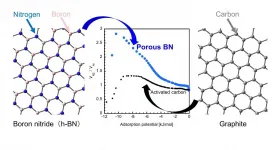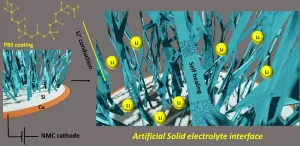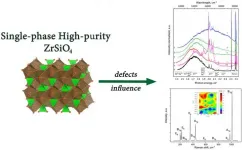Trapping gases better with boron nitride "nanopores"
Scientists demonstrate high-performance gas molecule confinement with "nanoporous" boron nitride, promising to replace standard porous carbon in future
2021-02-05
(Press-News.org) What is common between a technology for storing energy in a solar cell and that for water purification? They both rely on the use of porous materials, or more specifically, "nanoporous" materials that can trap gas molecules within narrow spaces on their surface, called "pores", which are only nanometers (one-billionth of a meter) in size! In chemistry parlance, the phenomenon is known as "adsorption" and has played an important role in the synthesis of porous materials of different compositions, pore sizes, and even pore geometries.
Traditionally, activated carbon (AC, or a porous form of carbon) has been a popular adsorbent for practical applications owing to its higher capacity of adsorption than that of other porous materials. Lately, however, porous boron nitride (p-BN) has emerged as a promising alternative because of its impressive performance, as highlighted by a recent study claiming that p-BN can adsorb a relatively large amount of carbon dioxide at room temperature.
Now, a group of scientists from Okayama University and Nagasaki University, Japan, has put this claim to the test in their latest study, where they examined the adsorbing characteristics of p-BN in detail. "A BN unit and two carbon atoms (i.e., CC) both have the same number of electrons and similar structures, but their interaction with gas molecules are different due to the atomically heterogeneous nature of BN. Despite this, there has been very little research on BN materials. In our study, we wanted to see if BN has specific adsorption properties that cannot be observed in carbon materials," explains Dr. Takahiro Ohkubo from Okayama University, who led this study published in the journal RSC Advances.
To begin with, the scientists synthesized p-BN samples at high temperature conditions under presence of nitrogen and investigated their structure using X-ray diffraction, infrared (IR) spectra analysis, and high-resolution electron microscopy. The samples only differed from one another with respect to the temperatures at which they were synthesized. While X-ray diffraction data and IR revealed an "amorphous" phase (lacking well-defined structure) BN comprising "hexagonal phase" BN (h-BN) microcrystals for all samples, the one treated at 1673 K (1400°C), called p-BN-1673, showed the most ordered structure. After examining it under the electron microscope, the scientists found that this sample was composed of stacked layers of curved sheets with nanometer-size pores formed in between.
The scientists next looked at thermogravimetric curves of the samples to estimate their stability against oxidation and discovered that it was directly linked to the synthesis temperature, with higher temperatures entailing higher stability. Moreover, some additional species of carbon and oxygen were introduced into the h-BN crystal framework especially in p-BN-1473, giving rise to chemically active sites for nitrogen adsorption. While these species ordinarily reduce oxidation stability, the crystallinity of h-BN helped preserve it up to 973 K under normal conditions--a property not present in carbon-based adsorbents!
Finally, upon comparing the gas adsorption ability of p-BN and AC with nitrogen and argon as adsorbates, scientists observed that p-BN pores adsorbed nitrogen more strongly than argon and in relatively much larger amount (~ 150%-200%) than did AC. They attributed this observation to an additional physical interaction between nitrogen and p-BN pores that was absent for argon, and the creation of adsorption sites in p-BN by the impregnated carbon and oxygen species.
With these results, the Dr. Ohkubo and team are confident about the emergence of p-BN as a next-generation adsorbent material. "Given its superior oxidation stability and nature of adsorption, we are looking forward to the applications of porous BN as a novel adsorbent and catalyst support material, especially in cases where the use of carbon adsorbents is not feasible," comments Dr. Ohkubo.
Looks like carbon is about to go out of fashion on yet another front!
INFORMATION:
[Attachments] See images for this press release:

ELSE PRESS RELEASES FROM THIS DATE:
2021-02-05
Treating severe COVID-19 patients with the anticancer drug bevacizumab may reduce mortality and speed up recovery, according to a small clinical study in Italy and China that was led by researchers at Karolinska Institutet in Sweden between February and April 2020. On average, blood oxygen levels, body temperature and inflammatory markers significantly improved in patients treated with a single dose of bevacizumab in addition to standard care. The research is published in Nature Communications.
"To reduce COVID-19 mortality, we aim to develop an effective therapeutic paradigm for treating patients with severe COVID-19," says corresponding author Yihai ...
2021-02-05
A research team led by Prof. HE Shunping from the Institute of Hydrobiology (IHB) of the Chinese Academy of Sciences has discovered through genome sequencing that the non-teleost ray-finned fishes--bichir, paddlefish, bowfin and alligator gar--exhibit mosaic genomic features of lobe- and ray-finned fishes. The study was published in Cell.
The water-to-land transition during the Devonian is one of the most prominent events in vertebrate evolution. During this transition, various organs underwent adaptive changes, particularly those related to locomotion and respiration systems.
Rich fossil evidence suggests that many traits and functions related to this terrestrial evolution were present long before the ancestor of lobe- and ray-finned fishes ...
2021-02-05
Although silicon anodes could greatly boost the capacity of Li-ion batteries, their performance rapidly degrades with use. Polymeric coatings can help solve this problem, but very few studies have explored the underlying mechanisms. In a recent study, scientists from Japan Advanced Institute of Science and Technology investigate how a poly(borosiloxane) coating greatly stabilizes the capacity of silicon anodes, paving the way for better and more durable Li-ion batteries for electric cars and renewable energy harvesting.
Since their conception, lithium-ion batteries (LIBs) have been constantly improved and adapted so that they can become suitable for vastly different applications, from mobile devices ...
2021-02-05
Researchers from the Department of Infection and Immunity of the Luxembourg Institute of Health (LIH) brought forward the potential of high doses of a specific adjuvant molecule, namely CpG oligonucleotide, in successfully modulating the immune system's allergic response to the main cat allergen Fel d 1, thereby inducing a tolerance-promoting reaction and reverting the main hallmarks of cat allergy. The researchers analysed the molecular mechanisms underlying this tolerance and proposed a pre-clinical allergen-specific immunotherapy approach to improve the treatment and control of this common type of allergy. The full study results ...
2021-02-05
Sudden cardiac arrest is more often fatal in people with COVID-19, a new study shows. Those responsible for the research see the results as a wake-up call for the public and care providers alike.
The survey now published in the
European Heart Journal is a register-based observation study. It covers all 3,026 cases of sudden cardiac arrest that were reported to the Swedish Registry for Cardiopulmonary Resuscitation in the period from 1 January to 20 July 2020 -- that is, both before and during the pandemic.
The Registry's statistics show that, in Sweden, there are 6,000 cases of sudden cardiac ...
2021-02-05
Ozone is a problematic air pollutant that causes serious health problems. A newly developed material not only quickly and selectively indicates the presence of ozone, but also simultaneously renders the gas harmless. As reported by Chinese researchers in Angewandte Chemie, the porous "2-in-one systems" also function reliably in very humid air.
Ozone (O(3)) can cause health problems, such as difficulty breathing, lung damage, and asthma attacks. Relevant occupational safety regulations therefore limit the concentrations of ozone allowable in the workplace. Previous methods for the detection of ozone, such as those based on semiconductors, have a variety ...
2021-02-05
Thermoelectric generators, TEGs for short, convert ambient heat into electrical power. They enable maintenance-free, environmentally friendly, and autonomous power supply of the continuously growing number of sensors and devices for the Internet of Things (IoT) and recovery of waste heat. Scientists of Karlsruhe Institute of Technology (KIT) have now developed three-dimensional component architectures based on novel, printable thermoelectric materials. This might be a milestone on the way towards use of inexpensive TEGs. The results are reported in npj Flexible Electronics (DOI: 10.1038/s41528-020-00098-1) and ACS Energy Letters (DOI: 10.1021/acsenergylett.0c02159).
"Thermoelectric generators directly convert thermal into electrical energy. This technology enables ...
2021-02-05
The scientific novelty of the work of scientists from Ural Federal University, Institute of Solid State Chemistry and Geology and Geochemistry of the Ural Branch of the Russian Academy of Sciences lies in the fact that for the first time scientists solved the task of creating zircon with certain spectral properties. To this end, they have worked out the so-called sol-gel method.
It is distinguished by its technological simplicity, controllability of processes and allows synthesizing a larger volume of products with high purity than with other ...
2021-02-05
Using patient data, artificial intelligence can make a 90 percent accurate assessment of whether a person will die from COVID-19 or not, according to new research at the University of Copenhagen. Body mass index (BMI), gender and high blood pressure are among the most heavily weighted factors. The research can be used to predict the number of patients in hospitals, who will need a respirator and determine who ought to be first in line for a vaccination.
Artificial intelligence is able to predict who is most likely to die from the coronavirus. In doing so, it can also help decide who should be at the front of the line for the precious vaccines now being administered across Denmark.
The result is from a newly published study by researchers at the University of Copenhagen's Department ...
2021-02-05
- World's wildlife, from giraffes to voles, kangaroos to coyotes being hit by aircraft.
- Study identifies incidences at airports in 47 countries across the globe.
- 'Runway Roadkill' increasing by up to 68% annually and has caused damage that has cost in excess of $103 million in the United States alone over a 30 year period.
- It is hoped study could pave way for international efforts to protect wildlife and reduce costly aircraft damage.
From giraffes to the world's smallest mammals, the world's wildlife is being increasingly struck by aircraft, a global study finds.
Airports from Sydney to London and the USA to Germany were examined by researchers who ...
LAST 30 PRESS RELEASES:
[Press-News.org] Trapping gases better with boron nitride "nanopores"
Scientists demonstrate high-performance gas molecule confinement with "nanoporous" boron nitride, promising to replace standard porous carbon in future







